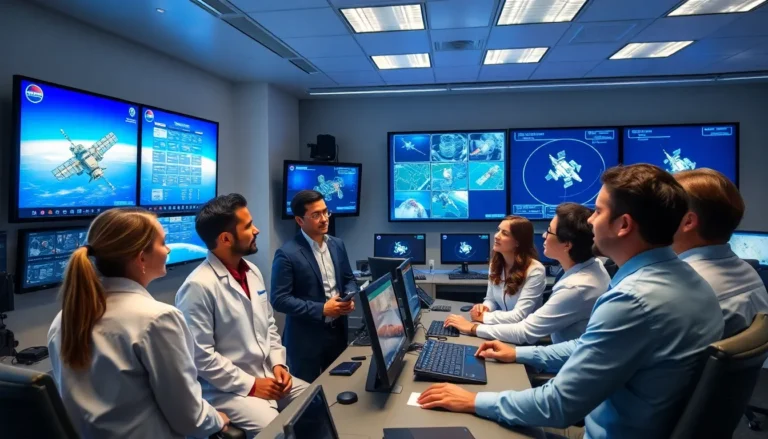Imagine a world where computers don’t just sit on your desk but transport you into the heart of your projects. Welcome to the realm of Z Space computers, where virtual reality meets high-performance computing. These innovative machines are more than just gadgets; they’re gateways to a dimension where creativity and technology collide in the most spectacular way.
With Z Space, users can manipulate 3D models as if they were made of Play-Doh. No more squinting at flat screens and wishing for a magic wand—this is the magic! Whether you’re an architect, engineer, or just someone who loves to play with tech, Z Space offers an immersive experience that’ll leave you wondering how you ever designed without it. Buckle up as we dive into the fascinating world of Z Space computers and discover how they’re revolutionizing the way we create and collaborate.
Table of Contents
ToggleOverview of Z Space Computers
Z Space computers integrate advanced virtual reality technology with high-performance computing, creating a unique platform for various industries. Users interact with 3D models in real-time, enhancing their ability to visualize complex designs. Architects and engineers greatly benefit from this hands-on manipulation, as it transforms traditional design workflows.
The hardware of Z Space computers includes powerful graphics processing units (GPUs) and high-resolution displays. These components enable detailed rendering of immersive environments. Collaboration occurs seamlessly, as team members can engage with the same models and ideas, regardless of their physical locations.
Software designed specifically for Z Space supports a range of applications. Programs utilize touch and spatial interaction, helping users to make quick adjustments and explore alternatives without barriers. Educational institutions also leverage Z Space, allowing students to learn in interactive and engaging ways.
Many industries, including healthcare and manufacturing, adopt Z Space technology. Medical professionals can visualize anatomy and improve surgical techniques through realistic simulations. In manufacturing, engineers streamline product design by testing and modifying virtual prototypes before physical production.
The impact of Z Space computers extends beyond individual use. Companies report increased innovation and efficiency due to improved collaboration and decision-making processes. These devices not only inspire creativity but also enhance productivity across various fields, positioning Z Space at the forefront of technological advancement.
Key Features of Z Space Computers

Z Space computers stand out due to their innovative integration of hardware and software, enhancing user experience across various applications.
Hardware Specifications
Powerful graphics processing units (GPUs) drive Z Space computers, ensuring high-quality rendering of intricate 3D models. High-resolution displays provide clarity, allowing users to inspect details closely. Unique spatial tracking systems enable accurate interaction with virtual environments, making movements intuitive and responsive. Multiple USB ports facilitate connectivity with other devices, streamlining workflows. These specifications empower users, particularly in architecture and engineering, to explore designs creatively.
Software Capabilities
Specialized software supports Z Space’s immersive environment, enabling users to manipulate 3D models easily. Real-time interaction allows for immediate adjustments, fostering innovation during the design process. Collaborative features enhance teamwork, allowing multiple users to engage simultaneously, regardless of distance. Educational applications utilize interactive learning modules that enhance student engagement. This suite of software tools ensures that Z Space can meet various industry requirements effectively, emphasizing versatility in various fields.
Advantages of Z Space Computers
Z Space computers deliver numerous advantages across various industries, especially in enhancing the design process and improving collaboration.
Enhanced Visualization
Enhanced visualization stands out as a crucial benefit. Users experience lifelike 3D representations, making it easier to comprehend complex designs. This immersive experience enables architects and engineers to engage deeply with their projects. Powerful graphics processing units render intricate details, resulting in superior clarity. Additionally, users manipulate virtual models in real-time, allowing for instant modifications and adjustments. This capability fosters innovation by enabling quick exploration of design alternatives. Ultimately, advanced visualization tools facilitate better decision-making and more effective communication of ideas.
Collaboration Opportunities
Collaboration opportunities expand significantly with Z Space technology. Teams can work together seamlessly, regardless of their physical locations. Shared virtual environments allow individuals to interact with the same 3D models simultaneously. Enhanced spatial awareness contributes to more meaningful discussions and feedback during design reviews. Companies report improved efficiency as team members streamline their workflow through real-time updates. As communication becomes more dynamic, the potential for collective brainstorming increases. These collaborative features not only drive innovation but also enable teams to arrive at better solutions collectively.
Applications of Z Space Computers
Z Space computers serve various industries with their innovative technology. They excel in education, training, design, and prototyping, enhancing both learning and collaboration.
Education and Training
Z Space technology transforms educational environments by offering immersive learning experiences. Students interact with 3D models, enabling deeper comprehension of complex concepts. Various subjects, from anatomy to engineering, benefit from this hands-on approach. Specifically, medical students visualize human anatomy in greater detail, aiding in their training. Meanwhile, engineering students test and manipulate design concepts, refining their skills. Educational institutions report increased student engagement when using Z Space systems in the classroom.
Design and Prototyping
Designers leverage Z Space computers for faster prototyping and visualization. By immersing themselves in 3D environments, teams can identify design flaws early on. Architects explore building layouts realistically, facilitating immediate adjustments. Engineers create virtual prototypes, speeding up the development process. Such immediacy leads to more innovative and effective solutions. Companies that adopt Z Space technology enhance collaboration among team members, regardless of their locations. Enhanced communication fosters teamwork that translates into successful project outcomes.
Market Competitors
Z Space computers face competition from several key players in the virtual reality and high-performance computing sectors. Companies such as Microsoft, with its HoloLens, provide immersive experiences for users across various industries. Unity Technologies also stands out, offering platforms that enable the creation of interactive 3D content. Additionally, Autodesk develops tools tailored for design professionals, further increasing competition in the market.
Competitors like PTC focus on augmented reality to enhance product development processes. Their Vuforia platform allows users to create augmented reality experiences that can integrate with existing workflows. Another rising competitor, Varjo, develops high-fidelity virtual reality headsets, pushing the boundaries of visual quality in immersive experiences.
Educational institutions benefit from these competing technologies. For instance, Magic Leap combines augmented reality with robust software solutions, making it appealing for educational and training purposes. Each of these companies brings unique strengths to the table, influencing user preferences and market trends.
In addition to established firms, startups also contribute to the competitive landscape. Companies like Sketchfab and nanoRemote emphasize cloud-based 3D visualization tools, appealing to designers and engineers alike. Their innovative approaches highlight the dynamic nature of this sector.
Industry-specific applications further intensify competition among market players. Healthcare-focused solutions, such as those from Osso VR, offer tailored platforms that allow medical professionals to practice surgical techniques using VR technologies. This focus on niche markets helps competitors differentiate their offerings.
By tracking advancements made by these competitors, it becomes essential for Z Space to continue innovating. Enhanced collaboration features and user-friendly interfaces remain critical in attracting new clients and retaining existing users.
Z Space computers represent a significant leap forward in how individuals and teams interact with 3D models. By merging virtual reality with high-performance computing, they create an unparalleled immersive experience that enhances creativity and collaboration.
Industries ranging from education to healthcare are discovering the transformative potential of this technology. As organizations embrace Z Space, they’re not only improving design processes but also fostering innovation and efficiency.
The future looks promising for Z Space as it continues to evolve and adapt to the needs of various sectors. Its commitment to enhancing user experience and collaboration will likely keep it at the forefront of technological advancements.




